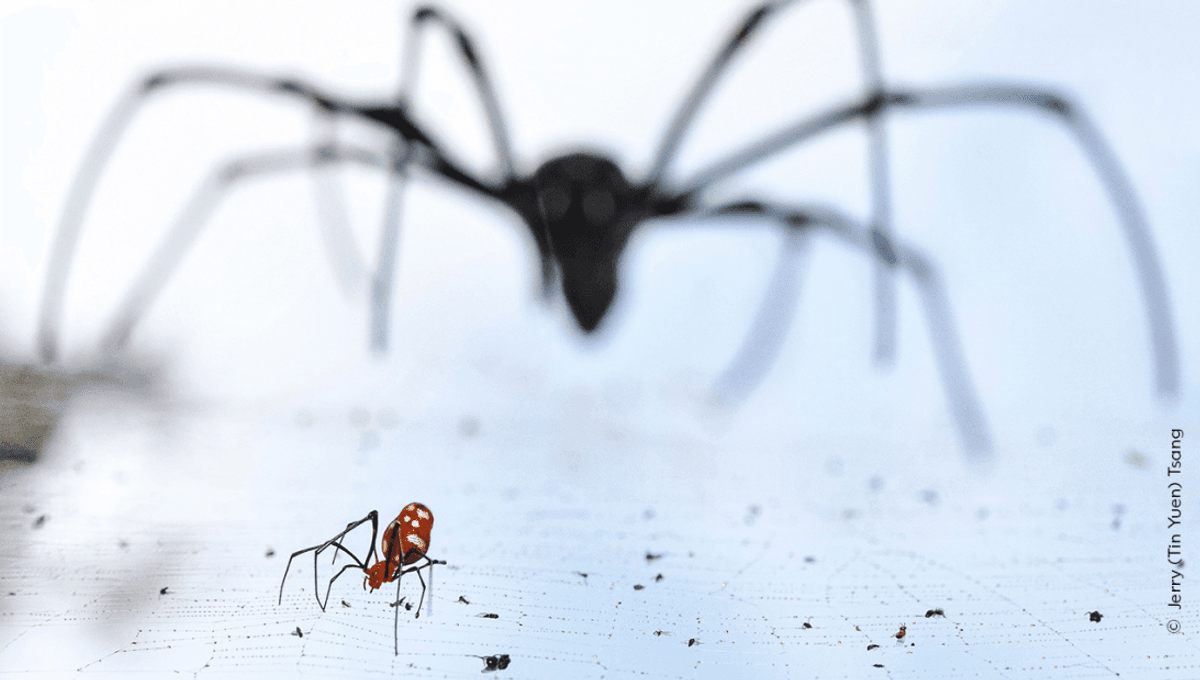
When IFLScience visited Wildlife Photographer of the Year 2023, there was one photo that really stopped us in our tracks. On the surface, it looks as if a small arachnid is about to meet its end at the hands (or legs, as it were) of a monstrous spider. However, when it comes to the battle of orb weaver versus dewdrop spider, it’s a lot more complicated than that.
The wildlife photographer behind the shot is Jerry (Tin Yuen) Tsang whose image “Living Dangerously” was highly commended in the Behaviour: Invertebrate category. Capturing it involved hanging out among the spiderwebs for two hours, Tsang told IFLScience, but the astonishing result tells a fascinating story.
“This is a very unique kleptoparasitic relationship between a golden orb weaver (Nephilia pilipes) and a dewdrop spider (Argyrodes sp). The Argyrodes lives by the web of the golden orb weaver rent-free as they themselves don’t build webs, snacking on any prey too small to be noticed by the big girl, and in some cases, the Argyrodes can even [feed] on the host itself when it moults and becomes defenseless.”
Looking at the enormous silhouette of the orb weaver looming behind the petite dewdrop, it’s hard to imagine that it’s not the latter who becomes dinner, and yet in this relationship, it’s the smaller of the two arachnids who poses the real threat. For Tsang, it was an altogether different invertebrate that was causing problems during the shoot.
“Although it sounds dreadful to be in spiderwebs for hours surrounded by five to eight spiders as big as your hand, I had fun as I’m the crazy spider guy (I have put them on my face before),” he told IFLScience. “The species of spider I’m photographing is called the Golden Orb Weaver because the webs they make actually look golden! It was glimmering under the harsh afternoon light and quite beautiful, the only thing I didn’t like was the mosquitoes that [were] slowly driving me mad.”
Tsang’s image features in the 2023 Wildlife Photographer of the Year exhibition alongside Laurent Ballesta’s winning image of a horseshoe crab, and another arresting highly commended shot of a stargazer captured by Pietro Formis. It’s an achievement many wildlife photographers covet and by all accounts an unforgettable experience to be selected.
“It was absolutely phenomenal!” Tsang continued. “When I stood in that hall with hundreds of world-class photographers, I knew that I [had] made it. I just want to congratulate all the participants and winners in this competition, I am honoured to stand alongside as an opponent, but also as a comrade, a comrade to fight against the world in means of saving our planet, our future, and ourselves.”
“Let us use art and facts to make the world a better place, and one day, we will see the sunrise on the horizon, brighter, higher, brimming with beautiful shades of gold and orange, more than it ever has before.”
Wildlife Photographer of the Year is developed and produced by the Natural History Museum, London, and is open from October 13, 2023 until June 30, 2024.
Source Link: Think This Giant Spider Is About To Eat The Small One? Think Again